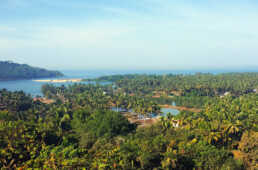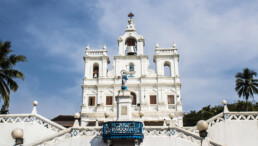Local Experiences
7 Hidden Beaches in North Goa
North Goa isn't just about crowded Baga and Calangute beaches – it's home to spectacular hidden coastal gems that offer tranquil escapes just minutes from Heritage Goa. These secret beaches provide the perfect blend of natural beauty, serenity, and authentic Goan charm away from tourist crowds. Whether you're seeking quiet sunset spots, pristine swimming waters, or Instagram-worthy photography locations, this guide reveals North Goa's best hidden beaches that most visitors never discover. If you're searching for secluded beaches in North Goa, hidden gems near Heritage Goa, or peaceful coastal spots for relaxation, this guide covers it all.
1. Querim Beach (Keri Beach)
Querim Beach, also known as Keri Beach, is North Goa's northernmost secret – a pristine stretch of golden sand that remains blissfully uncrowded. Located at the state's northern tip, this virgin beach offers crystal-clear waters ideal for swimming and spectacular sunrise views over the Arabian Sea. With no commercial beach shacks cluttering the coastline, it's pure untouched nature at its finest.
Distance from Heritage Goa: 45 minutes
Best For: Sunrise photography, meditation, peaceful walks, and romantic sunsets
2. Kakolem Beach (Tiger Beach)
Often referred to as Tiger Beach, Kakolem is a true hidden gem accessible only via a scenic 20-minute trek through dense vegetation. This secluded cove rewards adventurous visitors with dramatic cliff backdrops, pristine sands, and some of North Goa's most spectacular sunset views. The dramatic setting with natural rock formations makes it perfect for adventure photography.
Distance from Heritage Goa: 35 minutes + 20-minute trek
Best For: Adventure enthusiasts, photographers, couples seeking privacy, and sunset chasers
3. Mandrem Beach (North Section)
While Mandrem's southern section is well-known, the northern stretch near the Mandrem-Arambol border remains wonderfully quiet. This hidden section offers soft white sand perfect for beach walks, calm shallow waters ideal for families, and excellent dolphin spotting opportunities. The minimal commercialization and beautiful coconut palm groves create an authentic Goan beach experience.
Distance from Heritage Goa: 25 minutes
Best For: Family outings, morning yoga, beach reading, and peaceful swimming
4. Kalacha Beach (Half Moon Beach)
Kalacha Beach, also called Half Moon Beach, is a crescent-shaped hidden cove tucked between Arambol's main beach and the famous Sweet Lake. This natural amphitheater setting has become a haven for yoga enthusiasts and nature lovers seeking tranquility. The beach is famous for its butterfly season from October to March, creating magical natural spectacles.
Distance from Heritage Goa: 40 minutes
Best For: Yoga sessions, nature photography, peaceful sunbathing, and meditation
5. Morgim Beach (North Creek Section)
While Morjim's main beach is popular with tourists, the northern creek section near the Chapora River mouth remains a peaceful sanctuary. This area is famous for Olive Ridley turtle nesting and offers stunning backwater views with unique river-meets-sea landscapes. The peaceful fishing village atmosphere and excellent bird watching opportunities make it perfect for eco-conscious travelers.
Distance from Heritage Goa: 20 minutes
Best For: Wildlife enthusiasts, bird watchers, nature photographers, and turtle spotting (November-February)
6. Ashwem Beach (South Section)
The southern stretch of Ashwem, away from the main beach clubs, offers pristine conditions for water sports enthusiasts and authentic cultural experiences. With consistent waves perfect for surfing, traditional fishing boats, and local fishing village culture, it's less commercialized than central Ashwem while offering beautiful laterite cliff views nearby.
Distance from Heritage Goa: 30 minutes
Best For: Surfing lessons, cultural photography, authentic Goan experiences, and peaceful beach days
7. Ozran Beach (Little Vagator)
Often overshadowed by famous Vagator Beach, Ozran Beach (locally known as Little Vagator) offers dramatic red laterite cliff formations and a more intimate setting. This smaller, more secluded beach features natural rock pools during low tide and stunning sunset views, making it perfect for photography enthusiasts and romantic escapes.
Distance from Heritage Goa: 15 minutes
Best For: Photography enthusiasts, romantic escapes, sunset viewing, and cliff exploration
Whether you're seeking pristine swimming waters, dramatic cliff-backed coves, or peaceful turtle nesting sites, North Goa's hidden beaches offer diverse experiences just minutes from Heritage Goa. Each of these secret coastal gems provides authentic natural beauty away from commercialized tourist circuits, perfect for a tranquil escape after exploring heritage sites or bustling markets. If you're looking for secluded beaches in North Goa, peaceful coastal spots near Heritage Goa, or simply hidden gems for photography and relaxation, this list offers something for every traveler seeking authentic Goan experiences. Plan your hidden beach adventure and discover the unspoiled side of North Goa that few tourists ever experience!
The Majestic Panjim Church
The Panjim Church, situated on the slope of Conceicao Hill with its majestic stairway in the heart of Goa's capital, attracts thousands of visitors who come to experience its rich Portuguese heritage. Officially dedicated to Our Lady of the Immaculate Conception, this iconic white church towers over Panjim City and serves as one of Goa's most photographed landmarks. Whether you're exploring Panjim's Latin Quarters, visiting the Church Square, or discovering Portuguese colonial architecture near Heritage Goa, this magnificent Church offers a fascinating glimpse into Goa's Catholic history and architectural splendor. If you're searching for historic churches in Panjim, Portuguese heritage sites in Goa, or iconic landmarks near Fontainhas, this complete guide covers everything you need to know.
1. Rich History: From Hermitage to Parish Church
The Panjim Church has a fascinating origin story dating back to the early Portuguese period. Originally one of six "hermitages" (ermidas) constructed by Portuguese craftsmen, the Panjim ermida was the first to be upgraded to a Parochial Church in 1600 by Archbishop Don Frei Alexio de Menezes. As the Catholic population of Panjim grew rapidly, the original hermitage became insufficient, necessitating a complete rebuild from its foundations. The new Church was inaugurated in 1619 by Archbishop Frei Cristovao Sa e Lisboa and despite its imposing appearance, has a sitting capacity of only 400 persons.
Historical Significance: Over 400 years of continuous worship and community service
Best For: History enthusiasts, architecture lovers, cultural explorers, photography
2. The Iconic Church Square and Stairway
The area in front of the Panjim Church was once a paddy field with scattered huts and ponds when the entire region was part of Taleigao village. This has now transformed into the magnificent Church Square, one of Panjim's most vibrant public spaces. The main stairway, constructed in 1870 by trimming the front of the hillock, is known as "Escadaria de Igreja" and was artistically arranged with angled platforms providing majestic views of the entire city. On the second-last platform stands a marble statue of Our Lady on a pedestal that also serves as a pulpit for outdoor masses.
Architectural Feature: Three stairways plus one motorable road (Calcada Padre Rosa)
Best For: Sunset photography, city views, architectural appreciation, outdoor events
3. The Famous Second-Largest Bell in Goa
What immediately captures attention at the Church's façade is the massive bell weighing 2,250 kilos – reportedly the second largest in Goa after the Se Cathedral bell. This historic bell originally served at the Aguada lighthouse, ringing hours for passing ships. Brought to the Panjim Church in 1874, it took several years to install as the façade needed reinforcement, and tragically, two workmen lost their lives during the installation operations. The bell remains a powerful symbol of the Church's enduring presence over Panjim.
Historical Detail: Over 150 years hanging at the Church façade
Best For: Photography, historical tours, architectural details, maritime history
4. Connection to St Thomas Aquinas College
At a stone's throw from the original ermida stood the famous College of St Thomas Aquinas of the Dominican Order, where students studied Philosophy, Theology, Languages and the Arts. Unfortunately, the area was infested with poisonous cobras that caused deaths among members of the Order, forcing them to transfer just before the Panjim ermida achieved Church status. This fascinating connection reveals the challenges faced by early Portuguese settlers and the religious community in establishing institutions in Goa.
Historical Context: Dominican Order's influence on Panjim's early development
Best For: Educational tours, religious history, colonial period studies
5. The Cemetery and "Corte de Oiteiro" Mystery
Behind the Church on a hillock once stood the Church's cemetery, which had to be transferred when the hill was excavated to construct a road shortening the distance between Church Square and the famous Fontainhas Latin Quarters. This quaint road is known as "Corte de Oiteiro" (Portuguese for "cut hill"). Some graves from the eve of the transfer remain on the hilltop, including that of a European soldier rumored to have committed suicide. At the road's entrance near the main stairway sits a "Poco de Ossos" (bone well) known locally as "Addanchi bhain" where unclaimed bones were disposed.
Cultural Note: Monday blessings were performed for the old cemetery site
Best For: Ghost tours, historical mysteries, cultural anthropology, local legends
6. Magnificent Interior and Sacred Artworks
The Church's interiors are magnificently decorated with ornate paintings, carvings, and a majestic ceiling that provides a visual feast. The Pia Baptismal at the entrance features intricate carvings, artistic tiling, and embellishments used for infant baptisms over centuries. The floor is dotted with graves of eminent personalities and Church benefactors, while the pulpit opposite the Sacred Heart altar reflects the old practice of priests celebrating mass facing away from the congregation. The side altars are fully gold-plated with beautiful statues of angels holding crowns.
Special Feature: Century-old organ brought from Portugal in 1890
Best For: Religious art appreciation, interior photography, spiritual reflection, acoustic music
7. Famous Parish Priests and Annual Processions
Father Antonio da Rosa, known as "Padre Rosa," served as Vicar for 16 years and was remembered for his strict adherence to church dress codes. Father Claudio de Sa started the famous "Procissao de Velas" (procession of candles) in 1943, held every October 13th when the statue of Our Lady of Fatima is brought down from the Bishop's House along the beautiful Altinho road to the Panjim Church. This spectacular procession of music, light, and color has become one of Panjim's most beloved annual traditions attracting thousands of devotees and tourists.
Annual Event: Procissao de Velas every October 13th
Best For: Cultural festivals, religious celebrations, photography, evening spectacles
The Panjim Church still stands tall over Panjim City to this day, providing a beautiful backdrop steeped in legends and mysteries that continue to attract tourists from around the world. Located just 20 minutes from Heritage Goa in Siolim, this magnificent church offers an essential glimpse into Goa's Portuguese colonial heritage and Catholic traditions. Whether you're exploring the nearby Fontainhas Latin Quarters with its narrow lanes and cobbled streets, shopping at Church Square, or simply admiring the architecture, the Panjim Church remains an unmissable landmark. Plan your visit during the annual October candlelight procession for an unforgettable cultural experience, or attend Sunday mass to witness the Church's continuing role in Goa's spiritual life.

